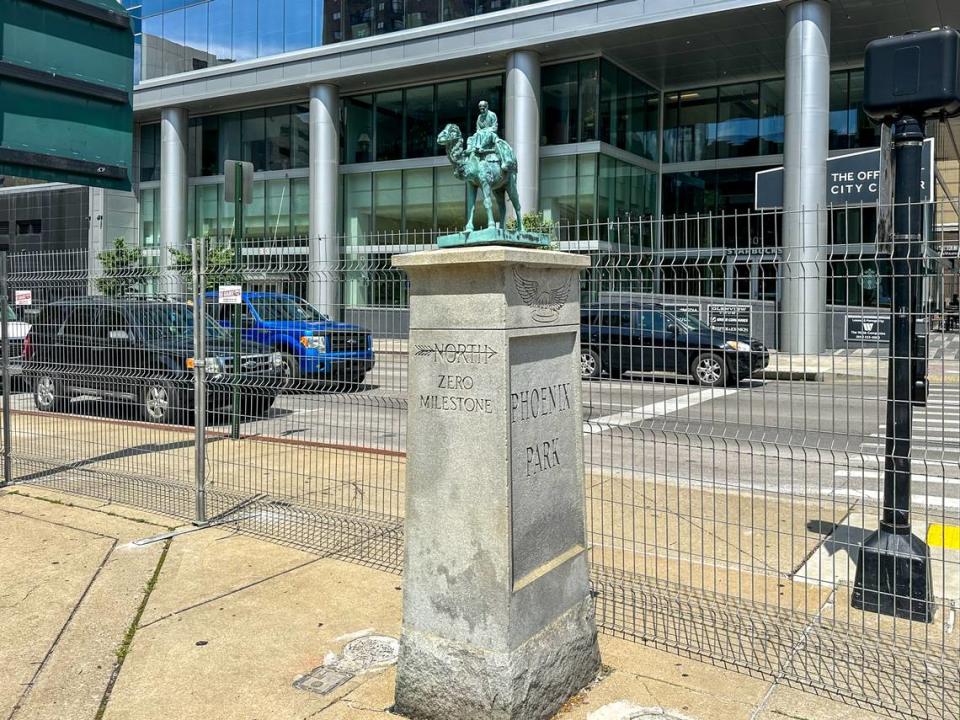There’s been a camel in downtown Lexington for almost 100 years. How’d it get there?
In our Uniquely Kentucky stories, Herald-Leader journalists bring you the quirky and cool, historic and infamous, beloved and unforgettable, and everything-in-between stories of what makes our commonwealth remarkable. Read more. Story idea? hlcityregion@herald-leader.com.
So, it’s really not a joke: Why is there a statue of a camel in downtown Lexington?
It’s easy to overlook the bronze-and-granite statue of a small man riding atop a small camel at the heart of the city at Main and Limestone streets. But it’s been there for a century, gracing an important corner of the horse capital of the world.
It’s a small statue, too. If you didn’t know it was at the southeast corner of Phoenix Park, you could breeze right by it on your way from the Mary Todd Lincoln House to the Kentucky Theatre.
Can you really consider a camel symbolic of Lexington?
For the tourists who happen to have the Zero Milestone Camel on their trip bucket list, it’s a brief stop. A picture or two before they’re on their way. But why, in a city known for its horses, does a camel older than most of its surrounding buildings exist?
A granite CEO’s vision
The monument was a gift to the Lexington Automobile Club from a local business executive named William M. Ingram. It was dedicated Nov. 20, 1926, according to a June 30, 1931, issue of the Lexington Leader.
He donated the monument to commemorate a victory for the city in procuring the route of U.S. Highways 25 and 60 through Lexington.
“I used the concept of Egyptian architecture, one of the oldest types,” Ingram told a Herald-Leader reporter in 1951.
Around the top edge of the monolith — also known as the cornice where Egyptians would put the insignia of creation — is a chiseled symbol of the American Automobile Association with “the buckskins of Hermes, the Greek messenger of flight,” Ingram said.
Modeled after the Zero Milestone in Washington, D.C. the monument is chiseled from granite from Winnsboro, South Carolina, fitting for Ingram, the owner of the Lexington Granite Co.
“That will resist the elements of the weather for thousands of years. The lines are Egyptian in keeping with the ancient yet modern milestone,” Ingram said at the dedication of the monument, according to a June 30, 1931 issue of the Lexington Leader.
“It’s the best of the Southern granites,” Ingram later remarked to Galloway.
But...why a camel?
Atop the block of granite rests the man and his camel. A surprisingly small statue, it was cast in bronze in Cincinnati, according to a July 7, 1981, issue of the Lexington Herald.
“The camel was chosen because it is one of the oldest methods of long-distance transportation for man,” Ingram told Lexington Leader reporter Kent Hollingsworth in 1960.
“In this particular case, (the camel) is coming down to get his directions on Route 60 or 25,” Ingram later told Galloway.

Lexington’s oldest traveler
In the same way the monument represents the traveler, the man and his camel have made their way through downtown Lexington over the past 98 years.
They began the journey on East Main Street in front of the old Union Station where trains would come in and out of the city, serving as a mile marker extending from Lexington outward.
“Somebody would tell you they’re 2.5 miles out of one of the major entranceways in and out of town,” said Bettie Kerr, Lexington director of historical preservation. “When they say, ‘I’m two miles out,’ the reference was that they were two miles from the mile marker.”
One side of the marker read “starting point from Lexington on all highways” with the logos of U.S. Highway 60 and U.S. Highway 25 before it was updated to bear the name of Phoenix Park, its current location.
After the train station closed and the building was torn down, the camel was relocated in 1961 to the old Fayette Courthouse lawn on West Main Street before reaching its current perch at Limestone and Main Street in the early 1990s, according to Kerr.
Why not a horse?
But why didn’t Ingram even consider a thoroughbred for the milestone? The answer is pretty simple: Lexington’s love of horses hadn’t rubbed off on him just yet.
According to a July 7, 1981, issue of the Lexington Herald, Ingram did not get involved in horse racing until a year after the dedication of the Zero Milestone was donated. The story goes that Ingram found two of his employees making bets with a bookmaker and began to make a few small bets himself.
A few years later, he made his first purchase of a horse.
The best horse he bred and raced was named Scotland, a reference to Ingram’s native country. The gray colt won stakes in four consecutive campaigns from 1958-1961.
So, is this small, easily missed camel a symbol of the city of Lexington?
Probably not, historians say.
Could it be a symbol of the storied history of Lexington outside of a racing legacy? A call back to a history that included a period of being the hub for travelers through its railways and highways?
It just could be.
Former Lexington Herald-Leader staff members Juliet Galloway, Bettye Lee Mastin and Kent Hollingsworth contributed to this story.


